DO TROUT HAVE TEETH?
Nov. 8th, 2021
Yes, all species of trout have teeth, including brown, bull, rainbow, and brook trout. So, the question becomes, “What type of teeth do trout have?”
In addition to sharp recurved teeth growing on the upper (maxillary) jaw and lower (mandible) jaw, these trout have two rows of movable vomerine teeth protruding from the roof of their mouth.
Vomerine teeth divide the nostrils, and trout use these teeth in cooperation with their tongues to manipulate and hold on to prey items such as baitfish, frogs, large insects, and crayfish. All trout are entirely carnivorous at all stages of life.
Trout don’t have molars, incisors, or fangs. Their denticulation is made up primarily of canine teeth, which includes the vomerine teeth.
Trout don’t lose and regrow rows of teeth like sharks, but they can regrow a tooth if it’s somehow lost or pulled-out.
In the below article I’ll include several pictures of trout teeth, as well as trout skulls I’ve found while fishing in various rivers. In fact, here’s a down-the-gullet picture of a brown trout I recently caught.
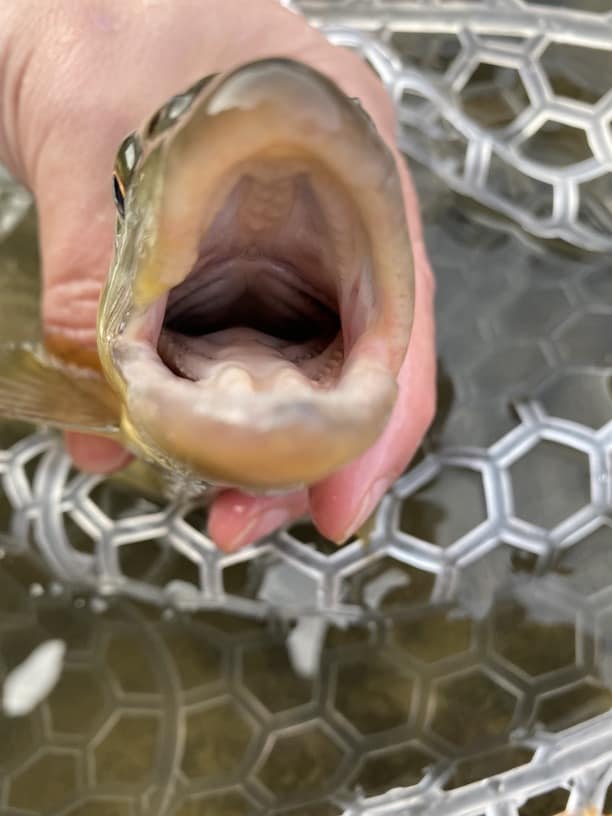
Do Brown Trout Have Teeth?
Do Rainbow Trout Have Teeth?
Do Brook Trout Have Teeth?
Do Cutthroat Trout Have Teeth?
Do Bull Trout Have Teeth?
Why Do Trout Need Teeth?
Can Trout Bite?
Can Trout Teeth Damage Flies?
Can Trout Bite Through Line?
Do Trout Have Jaws?
Can You Lip a Trout?
Summary
Do Brown trout have teeth?
Yes, brown trout have teeth. In fact, brown trout (Salmo trutta) have the largest teeth of the five most commonly caught species of trout.
Here’s a photograph of a brown trout skull I’m holding, showing their truly remarkable teeth, some of which are called “mousing teeth” since they’re good for holding rodent prey items.
Its appearance is reminiscent of a deep sea angler fish.
Brown trout use their impressive teeth to hold on to their primary prey item—other fish. Once brown trout reach about 14-inches in length, they become primarily piscivorous, meaning they’ll consume mostly fish for the rest of their lives.
But, browns aren’t choosy—they’ll gladly latch on to a frog, crayfish, and yes, even mice, when given the opportunity. They’re all about protein.
In the below picture I took, you’ll see just how formidable brown trout teeth are in reality.
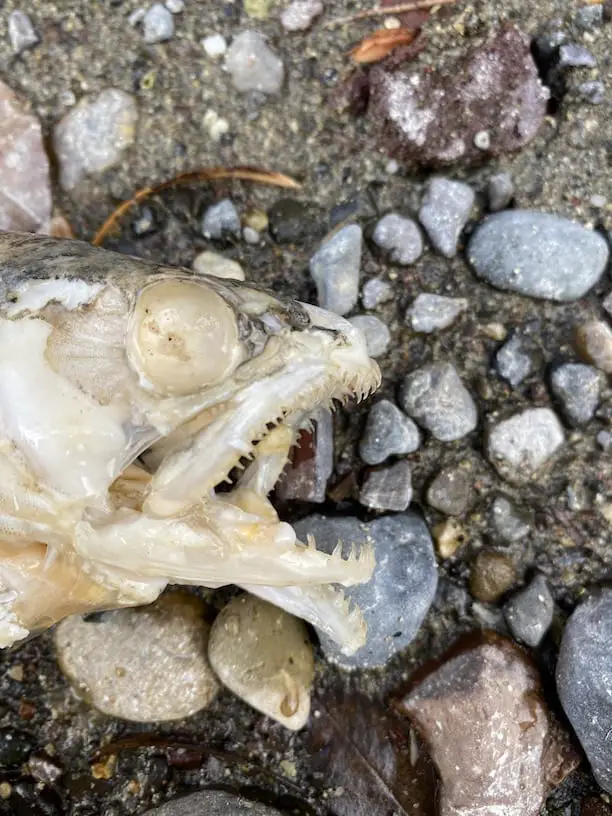
Here’s a brown trout skull that I pulled from the river. It’s reminiscent of those crazy anglerfish from the deep sea. Do trout have teeth? Why yes, yes they do.
Do Rainbow Trout Have Teeth?
Yes, Rainbow trout have teeth, although they’re not quite as long and recurved as the teeth found in a brown trout’s jaw. The reason for this is that rainbows aren’t as laser-focused on eating fish (and other large prey items) as they mature.
Rainbows (Oncorhynchus mykiss) will happily rise to small insects for most of their lives, taking in larger morsels when the opportunity arises. Sipping or rising to flies isn’t an activity that requires sharp teeth or chewing.
I can tell you from experience that rainbow trout are much better fighters than brown trout, although I’ve never heard an explanation as to why.
Do Brook Trout Have Teeth?
Yes, brook trout have teeth. While reminiscent of both rainbow and brown trout, brook trout are naturally much smaller fish, often caught in the 4-8 inch range. Because of this size difference, their teeth don’t appear overly large in comparison to their larger cousins.
The largest brook trout (Salvelinus fontinalis) in the world are usually caught in Labrador, Canada, where they can hit 14-pounds. In these cases, their teeth are very similar in size and shape to rainbows.
Brook trout are primarily insectivorous, and their prey items are generally quite small, so they don’t require large teeth for holding onto and subduing prey.
They generally live in cold waters—in fact, they require colder water than the other four trout species we’re talking about today. Cold water generally translates to smaller size, and fewer edible meals. This is why brook trout are very eager feeders.
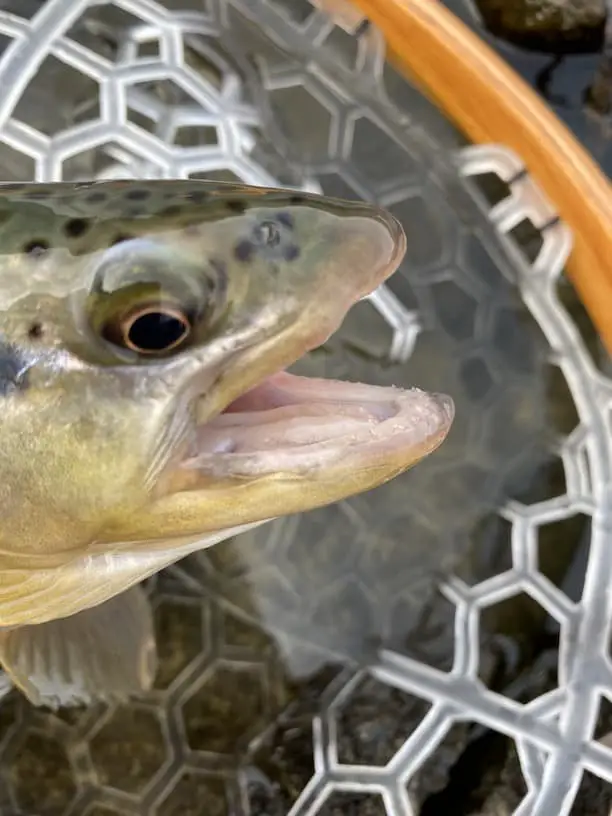
Do Cutthroat Trout Have Teeth?
Yes, cutthroat trout (Oncorhynchus clarkii) have teeth. However, they’re unique in that they also have basibranchial teeth (also called “Hyoid” teeth) at the base of their tongue, in between their gill rakers on their mandible jaw. These specialized teeth help them hold onto prey items such as insects with greater efficiency.
Do Bull Trout Have Teeth?
Yes, bull trout have teeth. It’s not immediately apparent, however, because an open-mouthed bull trout doesn’t visibly appear to have teeth at all. The smooth appearance of their jaw lines is deceiving, because they actually have recurved teeth just like brown trout, used for hunting fish.
Bull trout (Salvelinus confluentus) also become mainly piscivorous as they reach adulthood, and are most often caught on streamers that imitate baitfish.
Why Do Trout Need Teeth?
A trout’s teeth are used to catch and hold onto prey items, such as a mouse, minnow, frog, or large insect. They don’t need teeth for crushing or grinding, they need teeth for holding and killing.
Let’s use brown trout as an example. Here’s a picture of a 20-inch brown I caught recently.
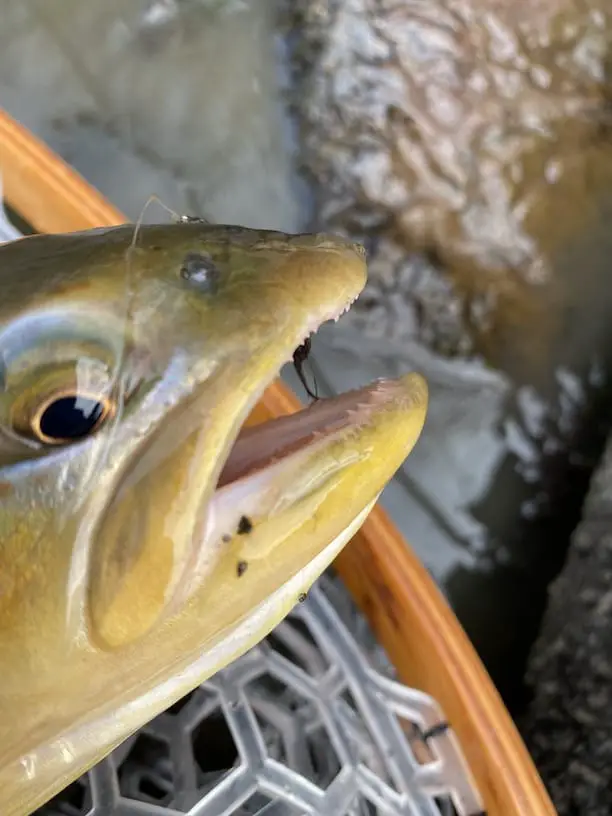
Aside from insects, large trout will attack and eat various large prey—mainly younger fish. A brown trout will always attack the head of a prey fish first. This way, they can hold onto the fish and kill it, either by drowning (ie. gills not able to function), or through brute force.
Once the prey fish is dead, the brown trout will position the fish so that it can be swallowed head-first. Trout will never try to swallow a fish tail first.
There are many instances of large brown trout being caught by fisherman, only to discover the fish had recently swallowed another trout half its own size.
Teeth play an important role for trout. Tearing-apart a full-sized crayfish with 2-3 inch claws is no easy task.
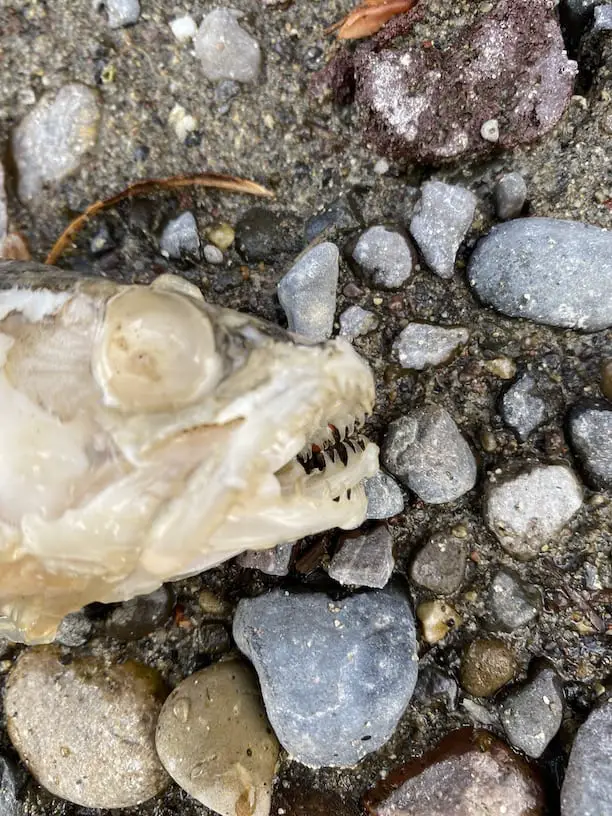
Can Trout Bite?
Yes, trout can bite, but not in the usual sense of the word. While trout do have strong jaws, swimming trout don’t attack fingers and toes. If you can sneak up to within three feet of a trout without spooking it, consider yourself a ninja. They stay alive by being afraid of everything.
Here’s a picture I took of the lower jaw of a brown trout. Check out those teeth!
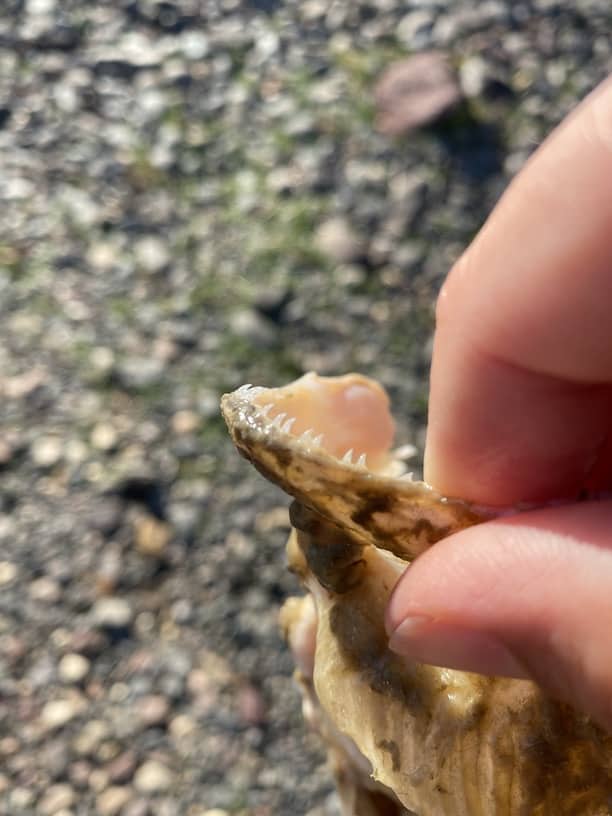
The only way a trout could conceivably bite you is if you were already holding it and you stuck your fingers into the fish’s mouth to retrieve a fly or lure. If this were to happen, it would almost certainly lead to a bloody wound. This is why you always want to use forceps to remove a hook from a trout’s mouth.
Trout will bite each other out of aggression, mainly during spawning season. I’ve seen plenty of brown trout swim by me with battle scars that are still healing.
It’s also common for bigger trout to bump or strike at smaller fish that invade the larger trout’s territory.
Do Trout Teeth Damage Flies?
Yes, trout teeth will damage flies over time. All trout have teeth, but certain species will beat-up your fly patterns more quickly, such as brown trout and rainbow trout. Generally speaking, you can catch quite a few trout before you’ll need to switch flies.
Can Trout Bite Through Fishing Line?
Yes, trout can bite through fishing line. Most fly anglers use tippet in the 4X to 6X range, and the higher the number, the easier it’ll be for the trout’s teeth to bite though the line. Brown trout have the sharpest teeth, and are most likely to snap your line. It’s a good idea to periodically check your line for fraying.
Do Trout Have Jaws?
Yes, trout have strong jaws that they use in conjuction with their sharp teeth to hold onto larger prey items that they can’t swallow whole. These prey animals would include grasshoppers, mice, shrews, frogs, and baitfish like sculpin and dace.
While a trout’s jaws can hold and kill prey, if their jaws are held open by an angler, trout cannot close their mouths with much force.
Can You Lip a Trout?
No, you shouldn’t lip a trout. In other words, you shouldn’t hold a trout out of water by its lower lip. This is ok for largemouth bass, but not trout. Trout have weaker jaws, and lipping a trout can also put unnecessary stress on the fish. Plus, trout have sharp teeth and you could cut yourself, especially if the fish wiggles.
Here’s a brown trout I caught. Check out the teeth on the fish’s tongue!
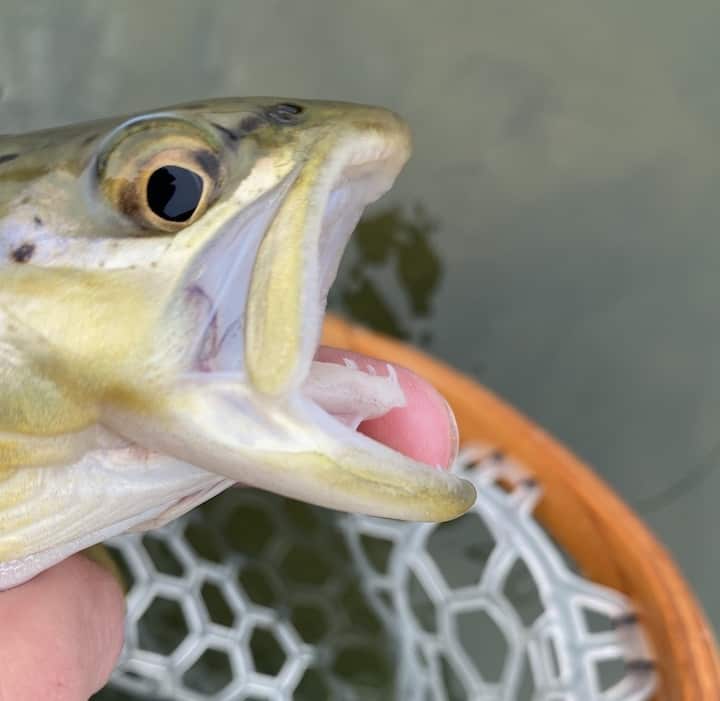
Summary
Trout are unrelenting predators that are almost always on the prowl for something edible. If you want to see how big trout appetites can be, check out my article on fly fishing for brown trout to see a fish that perished trying to consume a rabbit.
Because of their caloric requirements, small and medium-sized trout can’t go too long without eating. Bigger trout can eat very large meals, in which case they can spend up to 2-3 days digesting.
Trout are afraid of humans, so you don’t have to worry about one of them attacking you in the water while you’re wading or swimming. Just be careful if you’re an angler—always use forceps and keep your fingers away from their sharp teeth.
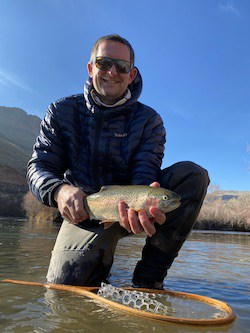
About the Author
My name's Sam and I'm a fly fishing enthusiast just like you. I get out onto the water 80+ times each year, whether it's blazing hot or snow is falling. I enjoy chasing everything from brown trout to snook, and exploring new waters is something I savor. My goal is to discover something new each time I hit the water. Along those lines, I record everything I learn in my fly fishing journal so I can share it with you.
Follow me on Instagram , YouTube, and Facebook to see pictures and videos of my catches and other fishing adventures!


